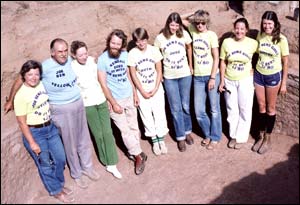Joe Ben Wheat and the Yellow Jacket Project
 |
Field crew and Joe Ben Wheat, 5MT3, 1980. (SL-YJ-254) |
The excavation methods at Yellow Jacket changed somewhat over time. In the beginning provenience locations were very basic with units excavated mainly dividing the fill above an occupation surface from the materials associated with occupation floors. By the mid-1960s the idea of arbitrary excavation units was commonly used to "divide up" a site into a rough grid of units. Although grid lines were not used, the most common arbitrary excavation unit was typically about two meters by two meters, or half this size. Once a structure or feature was defined, then the unit of excavation became the dimensions of that feature. Screening the sediment or soil to control artifact recovery was not common. Although screening was used to enhance the recovery of smaller items on floors or in specific contexts, only a small percentage of the excavation units have controlled recovery. Wheat's argument was that exposure of large areas of the site was more important for his research than obtaining large screened samples of artifacts from different proveniences.
The archaeological investigations were conducted in the summers from 1954 to 1991. There were three Ancestral Pueblo (or Anasazi) sites that were intensively investigated over this period. The dates of work and site areas varied from year to year and for certain years Joe Ben Wheat was focused on other projects on the Plains or of a more ethnographic nature. In spite of his many interests, Joe Ben's training of field school students remained a high priority in his career. The crew lists from all these seasons of work show many names of individuals that worked more than one year at the site. Crew were like family and Joe Ben Wheat was deeply devoted to his family.
